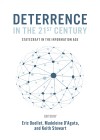Statecraft in the Information Age
University of Calgary Press, 2024, 400 pp
Print ISSN 1716-2645
Online ISSN 1925-2919
Editors: Eric Ouellet, Madeleine D’Agata and Keith Stewart
Reviewed by: Dr Cathy Moloney
One could be forgiven for thinking that this is just another book adapting the deterrence theory of old to a new buzzword-laden changing strategic environment. Yet Deterrence in the 21st Century: Statecraft in the Information Age is a significant contribution to the field of defence and security studies that steps away from conventional wisdom on deterrence and addresses the complex challenges posed by information warfare as ‘a new front of adversarial statecraft’ in the deterrence lexicon.
Responding to what the Canadian Armed Forces and the editors of the book identified as the concerning rise of disinformation, Eric Ouellet, Madeleine D’Agata and Keith Stewart have gathered leading scholars to answer a central question: how, if possible, can an enemy be deterred in the age of information warfare?
Structured into several sections, each delving into different aspects of deterrence in the information age, this book deftly draws the reader in, beginning with an overview of traditional deterrence concepts and how they have been adapted to address the unique threats of the 21st century. This is followed by themed sections examining evolving concepts, strategic contexts, Canadian context, and emerging tools and approaches.
Highlighting several key findings on modern deterrence strategies in the context of information warfare, each author demonstrates how traditional deterrence models, primarily focused on military might, are less effective in the information age. Instead, the authors emphasise the need for strategies that address cyber threats, disinformation, and the manipulation of public opinion.
At each turn we are presented with concepts, analysis, and solutions examining deterrence as an evolving concept—for example, whether classical or conventional deterrence methods such as denial and punishment can deter disinformation, by Christopher Ankersen; whether lessons from nuclear deterrence can be applied to challenges in other domains, by Adam Lowther; and what technological innovations are changing the reliability and stability of deterrence, by Sarah Jane Meharg.
While Rachel Lea Heide addresses major conflicts such as Russian approaches to information warfare in her chapter, and Ron Schleifer and Yair Ansbacher analyse Hamas in the Gaza conflict, an interesting section on radicalisation is presented which ordinarily would not be included in a book discussing deterrence. Anne Speckhard and Molly Ellenberg examine deterrence through the lens of online radicalisation and recruitment. This theme may seem at odds with the prevailing thinking on deterring kinetic force or coercion; however, if the aim of the book is to ask the audience to reconsider what we believe to be dangerous or a threat to national security, then having an understanding beyond the prevailing thinking is very important for a pathway to deter these threats.
Shining a spotlight on the role of information warfare as a focus in contemporary conflicts is one of the book’s strengths. It examines the various tactics adversaries use in information warfare, like data theft, disinformation campaigns, and cyber attacks to achieve strategic objectives without direct military confrontation. The contributors analyse how these tactics can undermine national security, and propose strategies to counteract them; each chapter challenges the reader and introduces new conceptual frameworks for understanding and implementing deterrence in the information age. These frameworks consider the psychological and social dimensions of deterrence, beyond just the technical aspects. The book considers the role of social, economic, and political factors in shaping deterrence strategies. This holistic approach is one of its key contributions, as it recognises that modern deterrence must be multifaceted to be effective and is of relevance in today’s world, where information is both a weapon and a target.
Another notable aspect of the book is its emphasis on empirical research and case studies. The contributors use real-world examples to illustrate their points, making the theoretical concepts more tangible and relatable. This approach not only enhances the book’s academic rigour but also makes it accessible to a broader audience, including policymakers and practitioners. Moreover, the authors offer policy recommendations for governments and institutions to enhance their deterrence capabilities. These include investing in cyber defence, improving public resilience to disinformation, and fostering international cooperation to counter information threats.
The editors have done an excellent job of ensuring that the book is cohesive, despite the diversity of its contributors. Each chapter builds on the previous ones, creating a logical progression of ideas. The writing is clear and engaging, making complex concepts understandable without oversimplifying them. Indeed, this book will cater to a broad audience, particularly those who enjoy challenging conventional thinking and/or find themselves drawn to trying to make sense of a world where information is weaponised, and of the challenges that this brings.
Deterrence in the 21st Century: Statecraft in the Information Age is a valuable resource for anyone interested in understanding the complexities of modern deterrence. It offers a thorough analysis of the challenges posed by information warfare and proposes practical strategies to address them. The book’s combination of theoretical insights, empirical research and real-world examples makes it a must-read.

